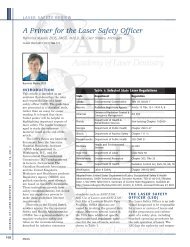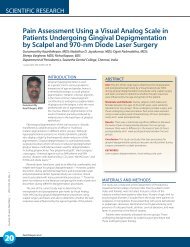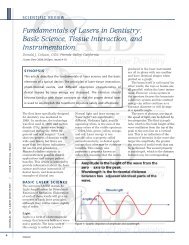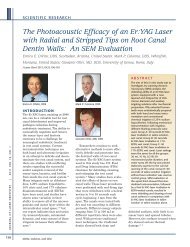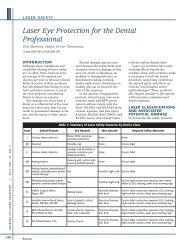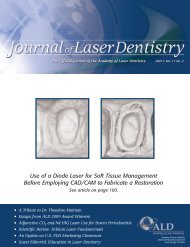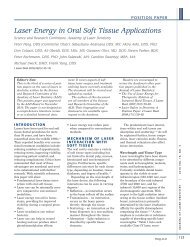Create successful ePaper yourself
Turn your PDF publications into a flip-book with our unique Google optimized e-Paper software.
was kept in constant motion. Care<br />
was taken to avoid keeping the tip<br />
in one place as this would lead to<br />
excessive heat buildup and cause<br />
damage to the underlying bone<br />
(Figures 3b-3c). The area was then<br />
irrigated with normal saline to<br />
remove the tissue debris. The entire<br />
procedure was completed in 30<br />
minutes. The 3-month postoperative<br />
examination revealed well-epithelialized,<br />
pink gingiva with few<br />
remnants <strong>of</strong> pigmentation (Figure<br />
3d). Similar to the other cases, pain<br />
measurements were performed.<br />
DISCUSSION<br />
Three cases were treated for<br />
gingival hyperpigmentation using<br />
laser, scalpel surgery, and electrocautery.<br />
Pain levels were evaluated<br />
using a Visual Analog Scale immediately<br />
after the procedure and 1<br />
week postoperatively. As can be<br />
seen in Table 1, immediately after<br />
the procedure, the VAS score for<br />
the patient treated with the laser<br />
was lower compared to patients<br />
treated with scalpel surgery and<br />
electrocautery, indicating the laser<br />
procedure produced less pain and<br />
discomfort. It can be theorized that<br />
this may be due to protein coagulum<br />
that is formed on the wound<br />
surface, which may act as a biological<br />
wound dressing 3 and seal the<br />
ends <strong>of</strong> the sensory nerves. 4<br />
In all three patients, healing<br />
was uneventful. A white fibrin<br />
slough was seen in Case 1 after 24<br />
hours; this is a normal characteristic<br />
<strong>of</strong> a laser wound during the<br />
first several days <strong>of</strong> healing. In this<br />
case, the “hot tip” <strong>of</strong> the diode laser<br />
produced a relatively thick coagulation<br />
layer on the treated surface.<br />
Bleeding that occurred during<br />
scalpel surgery was eliminated<br />
when laser and electrocautery were<br />
used. This can be attributed to the<br />
property <strong>of</strong> lasers and electrocautery<br />
instruments to coagulate<br />
bleeding vessels and thereby assist<br />
in providing a relatively dry<br />
surgical field.<br />
At the end <strong>of</strong> 6 months, all three<br />
treatment modalities provided<br />
satisfactory results in terms <strong>of</strong><br />
healing, repigmentation, and<br />
patient satisfaction. Few patchy<br />
areas <strong>of</strong> repigmentation were<br />
observed in the cases treated with<br />
electrosurgery and laser. This could<br />
be due to deeper pigmentation in<br />
these cases.<br />
CONCLUSION<br />
Within the limitations <strong>of</strong> this study,<br />
the use <strong>of</strong> a diode laser is shown to<br />
be a safe and effective treatment<br />
modality to provide optimal<br />
esthetics and enhanced comfort<br />
with reduced discomfort to the<br />
patients during the treatment for<br />
gingival hyperpigmentation. A<br />
longitudinal investigation <strong>of</strong><br />
similar treatments in a larger<br />
patient population would be helpful<br />
to confirm these findings.<br />
AUTHOR BIOGRAPHY<br />
Dr. Mihir Khakhar received his<br />
BDS from the Maharashtra<br />
University <strong>of</strong> Health Science,<br />
Nashik, India in 2008 and is<br />
currently pursuing his MDS in peri-<br />
C A S E R E P O R T S<br />
Table 1: Visual Analog Scale (VAS) Scores for All Three Cases<br />
VAS Scores<br />
Immediately Postoperative 1-Week Postoperative<br />
Case 1 8 3<br />
Case 2 15 4<br />
Case 3 10 3<br />
odontics at Saveetha University in<br />
Chennai, India. He has been a delegate<br />
at various national conferences<br />
on periodontics, implant dentistry,<br />
and general dentistry and has<br />
received awards for poster and<br />
paper presentations. He is also<br />
working on a research project<br />
related to the molecular pathogenesis<br />
<strong>of</strong> periodontal diseases. He can<br />
be contacted via e-mail at<br />
mihirkhakhar@gmail.com.<br />
Disclosure: Dr. Khakhar has no<br />
commercial affiliations or conflicts <strong>of</strong><br />
interest.<br />
REFERENCES<br />
1. Volker JF, Kenney JA Jr. The physiology<br />
and biochemistry <strong>of</strong><br />
pigmentation. J Periodontol<br />
1960;31(5):346-355.<br />
2. Dummett CO. Overview <strong>of</strong> normal<br />
oral pigmentations. J Indiana Dent<br />
Assoc 1980;59(3):13-18.<br />
3. Fisher SE, Frame JW, Browne RM,<br />
Tranter RMD. A comparative histological<br />
study <strong>of</strong> wound healing<br />
following CO2 laser and conventional<br />
surgical excision <strong>of</strong> canine<br />
buccal mucosa. Arch Oral Biol<br />
1983;28(4):287-291.<br />
4. Schuller DE. Use <strong>of</strong> the laser in the<br />
oral cavity. Otolaryngol Clin North<br />
Am 1990;23(1):31-42. nn<br />
Khakhar, et al.<br />
J O U R N A L O F L A S E R D E N T I S T R Y | 2 011 V O L . 19 , N O . 3<br />
285





